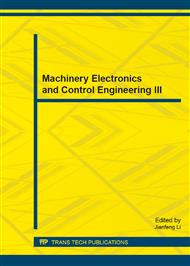p.22
p.26
p.31
p.36
p.40
p.44
p.48
p.53
p.58
The Simulation Experimental Research on Large Diameter Fresnel Lens Mold Machining
Abstract:
Reasonable selection and optimization of cutting parameters is an important part of the study on large diameter Fresnel lens mold process, which has a direct impact on the dynamic stability of processing state and processing quality of the large diameter Fresnel lens mold. Through a large number of experiments, we analyzed and summarized the influence law of spindle speed, feed and cutting speed on the dynamic stability of large diameter Fresnel lens mold processing state; The experiments show that when the cutting speed is more than 120m/min and the feed is about 1μm/r ~1.5μm/r , the continuous chip forms , breaks easily, the relative vibration amplitude between workpiece and tool is low, the cutting process is continuous and stable, and the machined surface quality is fine. The experiment results provide an important basis for the actual production of large diameter Fresnel lens mold.
Info:
Periodical:
Pages:
40-43
Citation:
Online since:
December 2013
Authors:
Keywords:
Price:
Сopyright:
© 2014 Trans Tech Publications Ltd. All Rights Reserved
Share:
Citation:


